By Karen Brettell and Samuel Indyk
NEW YORK/LONDON (Reuters) -The dollar edger higher on Friday but is set to end 2023 with its first yearly loss since 2020 against the euro and a basket of currencies, on expectations the U.S. Federal Reserve will begin cutting rates next year as inflation moderates.
Questions for 2024 will be when the Fed begins cuts, and whether the first rate reduction is made to avoid over-tightening as inflation drops, or due to slowing U.S. economic growth.
With markets already pricing in aggressive cuts, debate is also focused on how much further the dollar is likely to fall.
“We’ve already weakened quite a bit in anticipation of a Fed cut cycle to come,” said Brad Bechtel, global head of FX at Jefferies in New York.
The dollar's decline accelerated after the Fed adopted an unexpectedly dovish tone and forecast 75 basis points in rate reductions for 2024 at its December policy meeting.
Markets are pricing in even more aggressive cuts, with the first reduction seen likely in March and 158 basis points in cuts expected by year-end.
The Fed’s tone contrasted with other major central banks, including the European Central Bank (ECB) and Bank of England (BoE), which maintained they will hold rates higher for longer.
But “I do think they will capitulate. European growth is just struggling too much and inflation’s coming down relatively fast … same in the U.K. in many ways,” said Bechtel. “If all three central banks are cutting, it's going to be very hard for the dollar to weaken significantly."
Against a basket of currencies, the greenback on Friday gained 0.13% to 101.32, rising from a five-month trough of 100.61 reached on Thursday. It is on track to lose 2.10% this year and is down 4.62% this quarter, the worst performance in a year.
The euro dipped 0.19% to $1.1040, hovering just below a five-month peak of $1.11395 reached on Thursday. It is heading for a 3.04% gain for the year, its first positive year since 2020.
"Markets are looking for a cut earlier in the U.S. and are less certain that the European Central Bank will cut as quickly, so that's why the dollar is very soft," said Niels Christensen, chief analyst at Nordea.
"We also have positive risk appetite which is another negative for the dollar. Going into 2024, the soft dollar will be a theme towards the March central bank meetings," Christensen added.
Policymakers at the ECB and the BoE did not signal any imminent rate cuts at their policy meetings this month, but traders are pricing in 162 bps of cuts by the ECB next year, with the probability of two cuts by April. The BoE is also expected to cut rates by 148 bps in 2024.
"While it feels like the market might have moved too far too fast, the facts are that growth is non-existent in Europe, slowing in the U.S., and inflation is falling globally," said CJ Cowan, portfolio manager at Quilter (LON:QLT) Investors.
"The ECB is famously slow to change policy course so almost two cuts priced by April looks aggressive, even if it might be the right thing to do."
Sterling rose 0.08% to $1.2745 and was on track for a 5.39% yearly gain, its best performance since 2017.
YEN IS AN OUTLIER
The dollar is expected to post an annual 7.56% gain against the yen as the Japanese currency stays under pressure from the Bank of Japan's (BOJ) ultra-loose monetary policy stance.
Market expectations are for the BOJ to exit negative interest rates in 2024, though the central bank continues to stand by its dovish line and has provided little clues on if, and how, such a scenario could play out.
"The outlook for Japan is encouraging going into 2024, with expectations of robust economic growth and improving inflation that shows signs of being sustainable," said Aadish Kumar, international economist at T. Rowe Price.
That said, even if the BOJ hikes rates into positive territory, they will still remain much lower than in the United States.
“For all of 2024, if they got to positive 50 basis points I would be kind of surprised, but maybe that happens, and if the Fed gives us three rate cuts, you’re still looking at an interest rate differential of roughly 4.5% or so, which makes the yen very expensive to own,” said Jefferies’ Bechtel.
The yen is a popular funding currency, and investors use proceeds from shorting the yen to purchase other assets.
The Swiss franc is one of the best performing currencies this year, with the greenback losing 8.99% against the currency, the worst drop since 2010.
In cryptocurrencies, Bitcoin fell 1.23% to $42,059. It is on track for a 154% gain this year.
========================================================
Currency bid prices at 3:00PM (2000 GMT)
Description RIC Last U.S. Close Pct Change YTD Pct High Bid Low Bid
Previous Change
Session
Dollar index 101.3200 101.2000 +0.13% -2.097% +101.4200 +101.0600
Euro/Dollar $1.1040 $1.1062 -0.19% +3.04% +$1.1084 +$1.1039
Dollar/Yen 141.0200 141.4050 -0.27% +7.56% +141.9100 +140.8000
Euro/Yen 155.69 156.43 -0.47% +10.97% +156.9200 +155.6600
Dollar/Swiss 0.8413 0.8448 -0.38% -8.99% +0.8446 +0.8357
Sterling/Dollar $1.2745 $1.2735 +0.08% +5.39% +$1.2772 +$1.2702
Dollar/Canadian 1.3238 1.3229 +0.08% -2.28% +1.3265 +1.3179
Aussie/Dollar $0.6814 $0.6829 -0.22% -0.04% +$0.6846 +$0.6782
Euro/Swiss 0.9289 0.9342 -0.57% -6.12% +0.9347 +0.9255
Euro/Sterling 0.8660 0.8686 -0.30% -2.08% +0.8701 +0.8661
NZ $0.6320 $0.6333 -0.19% -0.46% +$0.6359 +$0.6306
Dollar/Dollar
Dollar/Norway 10.1520 10.2060 -0.80% +3.16% +10.1990 +10.1100
Euro/Norway 11.2128 11.2800 -0.60% +6.85% +11.2899 +11.1831

Dollar/Sweden 10.0873 9.9876 +0.79% -3.08% +10.0887 +9.9688
Euro/Sweden 11.1353 11.0484 +0.79% -0.13% +11.1390 +11.0395